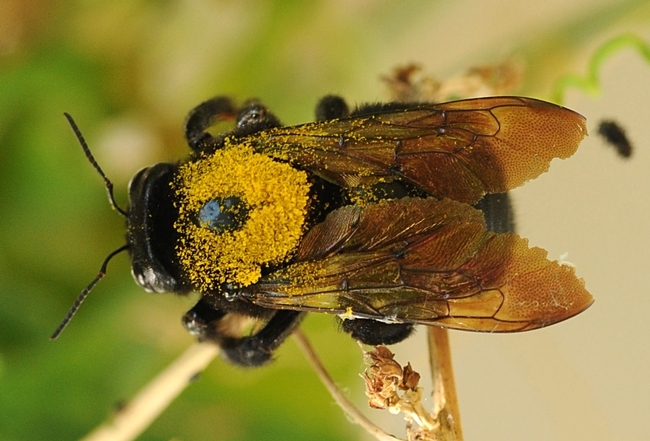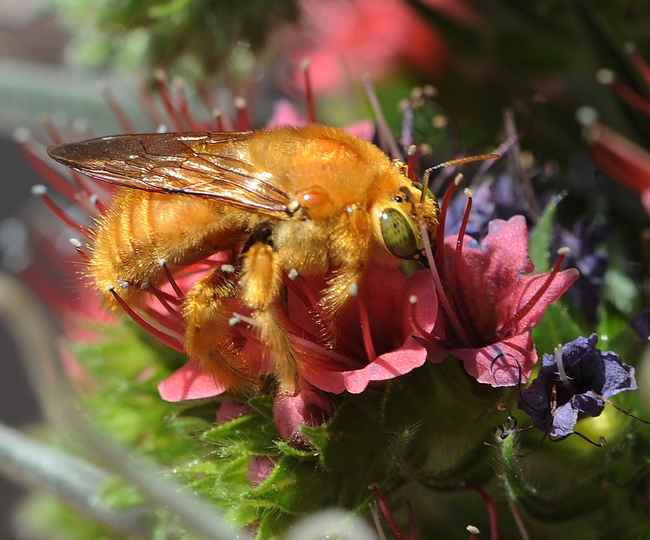- Author: Rachael Freeman Long

Carpenter bees (Xylocopa spp.) look like bumble bees. The largest in California are the Central Valley carpenter bees (X. tabaniformis orpifex), more than an inch long. The females are solid black, but the males are golden-blond. The males are sometimes nicknamed “teddy bears” because of their soft, burly, and fuzzy appearance. (See the three California species at http://entomology.ucdavis.edu/news/valleycarpenterbees.html).
Carpenter bees nest in soft wood and pithy stems of plants. Nests usually consist of tunnels half of an inch in diameter and 6-to-10 inches deep and may include several brood chambers. Carpenter bees may buzz like saws when constructing nests (hence their name), but they do not eat the wood. Instead, they forage on flowering plants, feeding on nectar, with the females collecting pollen for their offspring. When they have a sufficient plug of pollen in a chamber, females lay an egg on it, and then seal the chamber with woodchips. Another plug of pollen is then added for numerous chambers per tunnel. Development from egg to larva to adult may take about three months. Carpenter bees overwinter as adults, often in old tunnels. There is only one generation a year.
Like other native bees, carpenter bees are important pollinators in native plant communities, gardens, and in some crops. As they visit flowers and feed on nectar, they pick up and transfer pollen. We depend on insect pollination for a third of our food, including fruits and vegetables, nuts (almonds) and seed crops. Insect pollinators such as honey bees contribute a value of around $29 billion to our agricultural industry with about 15 percent of this value coming from native bees like the carpenter bees. Insect pollinators are also important for pollinating wild plants, contributing a food source for birds and other wildlife.
Some people consider carpenter bees pests because they drill holes or nest in wooden structures. However, their contribution to pollination far outweighs any damage to structures, according to native pollinator specialist Robbin Thorp, emeritus professor of entomology at UC Davis. Unlike the eastern carpenter bee species, which can be damaging to wooden structures, our Central Valley carpenter bees choose softer substrates for their nests such as pithy stems of plants, old logs, and untreated redwood. Using untreated, unpainted redwood for arbors, fences and patio or lawn furniture in this area means learning to share with carpenter bees.
So, before getting out your bottle of insecticide spray for controlling carpenter bees, or plugging their nesting holes, think again about their benefits. Thorp considers the use of any pesticides in the hands of untrained homeowners to be a greater risk to their health and safety than carpenter bees ever will be. Carpenter bees nest in his wisteria-covered arbor and he is most happy to live with them.
With a decline in bee pollinators due to diseases, pests, pesticides, stress, and malnutrition, enjoy the presence of these flashy bees, as they are important pollinators.





However, the Eastern Carpenter Bee, Xylocopa virginica is perceived as a problem burrowing in wood structures. There is lots of information on the web about them and their control and eastern pest control companies have a lot of experience dealing with them..
Seems pretty straightforward to me - I'm keeping them. I might even name them. People pay for bees to be brought to their property for pollination.
The damage will also depend on where you live. The ones in the article are less of a problem than the eastern version which is currently poking holes in my deck.
Did you read a word of it? Do you seriously think pollination creates flowers? Did you show up to any of your high school science classes?
Flowers exist to attract pollinators. Pollinators (bees/bats/birds) enable reproduction and the creation of fruits/nuts/seeds. These are things that people and animals eat. This is important because people and animals need to eat to survive. (In fact, while we can NOT survive without food, we CAN survive without houses.)
So we can kill off all the pollinators and cut off our food supply and all die of malnutrition, but your house will still be there without you. Good job.
*sigh*
Go back to the beginning and read the article over again before you say something publicly and embarrass yourself (again).
.I sprayed WD 40 and out came what I thought was
Bee
I went online and discovered it to be a carpenter bees.I have a vegetable garden and will try citrus oil next time
I recycle and try not to get in Mother Nature's way.
I agree with you wholeheartedly and at the same time, Kristen simply didn't know any better. That's unfortunately the world we live in ~ people don't have a connection to the life cycle. It takes exposure and getting the information out there to bring the people back. She might have received the information more readily without attack. Instead of taking in the good info you offered, she may be distracted by the new one you tore her and missed it altogether. You have a right to be angry at the ignorance in this world, but the only way we're going to help turn it around is by meeting people where they're at.
I tend to want to keep these bees around as we have seen a huge decline in our honey bees out here in the west. In fact, I've not seen one honey bee this year so far :( and it's kind of odd but they are dying off I fear.
Our native solitary bees often shut down adult activity during hot periods without resources. The life cycle continues in brood developing within previously provisioned nests.
Most solitary bees will not visit hummingbird feeders despite the rewards available.
I want to put a couple of posts into the ground near the house but away from where we normally go. I am going to attach some untreated boards so they can nest in there. We will see what happens.
At first I tried to get rid of them, but eventually I noticed that they were doing most of the pollinating of my fruits and vegetables. That, and these little buggers are much tougher than they look.
They are docile and will fly right up to about 18 inches from my face. If they get in the way, I'll wave them off and they go about their business. The only individual that got stung was my dog Mollie, who thought catching bees out of the air was great fun until she got stung.
So these critters have been around my house since before *we* could fly, yet the schoolhouse is no worse for wear. The colony seems to be the same size every year, so attrition seems to be keeping the population in check.
The kids have learned that there is nothing to be afraid of, and have got to the point where they just ignore them.
They feed the birds and keep the wasps away, what more could you ask for?
The bees come back every spring and I find them fascinating. The nest seems to have one bee on the watch and I can see the same bee for days and weeks buzzing in the air in front of the bay window and fighting off other bees that come by. I often go out and look at the watch bee who is at first irritated and tries to scare me away by buzzing really loudly towards my head. But eventually she gets used to me being there and just buzzes on. Sadly, after a few weeks that bee is always gone and I find her dead on the ground near the nest.
I love the carpenter bees who live on the deck. They drill holes in the 12x2" boards (not pressure-treated) that hold up the lightweight roof.
I have a solar-powered water fountain for the birds and the bees who grace the garden, and have planted native flowering plants for them.
Carpenter bees are so important, as are all bees. The perfect garden is a bit messy, because it's designed to support wildlife.
I’m happy to report there’s a clan of carpenter bees building there home near an old stump near the front of my house here on the island. We’ve all been worried about the bee population after Hurricane Maria and sounds like they’re making a good come back!
Quick question: if I move the stump to an abandoned lot next door full of chickens, banana trees, and other fruit trees will the bees know where to go? I’m more than happy to leave them where they are too just wasn’t sure if they have swarming tendencies and don’t necessarily want to walk into a swarm first thing in the morning out my front door…
Anyway, thanks for a great article and for all the comments. I’ve learned quite a bit already!